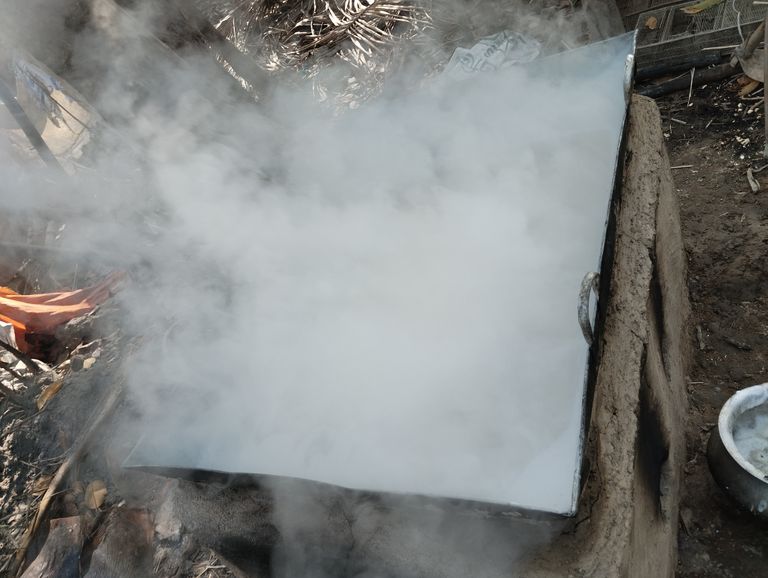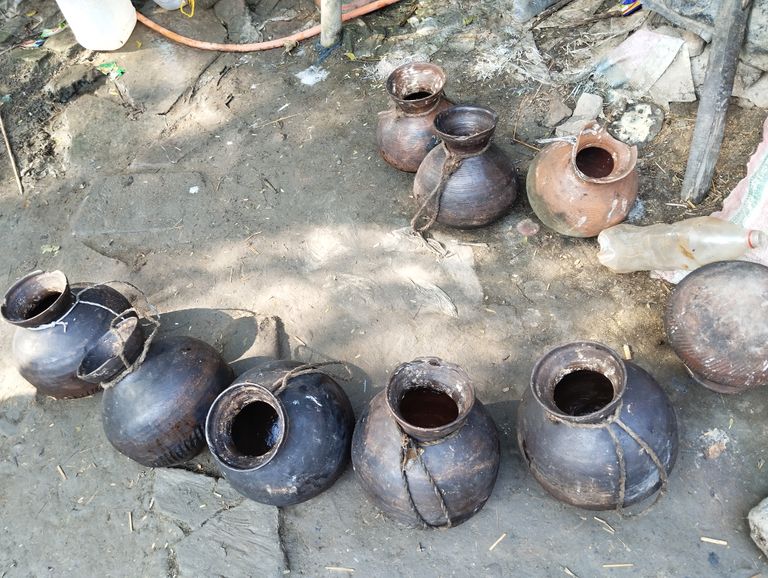
How to Prepare Pots for Tying on Date Palm Trees.
Date palm trees, known for their sweet sap, are commonly tapped in many regions for making traditional drinks, jaggery, or molasses. A crucial step in this process is preparing and using clay pots (locally called hari) to collect the sap from the trees. This article provides a comprehensive guide to preparing pots for tying on date palm trees, ensuring they are ready for effective sap collection.
Understanding the Role of Pots in Sap Collection
The date palm tree produces sap when the tree trunk or stem is skillfully cut. This sap is collected in clay pots hung from the tree. Using properly prepared pots is essential for collecting pure sap, preventing contamination, and maintaining the freshness of the collected liquid.
Step-by-Step Guide to Preparing Pots
- Choosing the Right Pot
Material: Use traditional clay pots as they are porous, keeping the sap cool and fresh.
Size: The pot should be large enough to hold the expected amount of sap without overflowing.
Durability: Check for cracks or weak spots in the pot. Discard pots that are damaged.
- Cleaning the Pot
Rinse the pot thoroughly with clean water to remove dirt or debris.
Soak the pot in a solution of warm water and salt for 24 hours. This helps to remove impurities and strengthens the pot.
After soaking, scrub the pot gently with a clean brush and rinse with fresh water.
- Drying the Pot
Allow the pot to air dry completely in sunlight. This step is crucial for maintaining hygiene and ensuring the pot is ready to absorb any treatments.
- Coating the Inner Surface
Purpose: Coating the pot helps to prevent sap fermentation and contamination.
Materials: Traditionally, lime paste or wood ash is used.
Prepare a thin paste of lime or ash and water.
Apply the paste evenly to the inside of the pot using a brush or clean cloth.
Allow the coating to dry completely before using the pot.
- Sterilizing the Pot
Before use, sterilize the pot by boiling it in hot water or steaming it for 10–15 minutes. This step ensures that no harmful bacteria remain inside the pot.
Tying the Pot to the Date Palm Tree
Once the pots are ready, the next step is to tie them securely to the tree. Follow these steps:
- Preparing the Tree
Select a mature and healthy date palm tree for tapping.
Clean the surface where the cut will be made to remove dirt or debris.
- Making the Cut
Use a sharp, clean tool to make a diagonal incision on the tree trunk. The cut should be deep enough to allow the sap to flow but not so deep as to damage the tree.
- Attaching the Pot
Position the prepared pot just below the incision.
Use strong ropes or jute strings to tie the pot securely to the tree. Ensure the pot is stable and won’t fall off due to wind or other disturbances.
Tips for Effective Sap Collection
Timely Harvesting: Collect the sap early in the morning to ensure maximum freshness and avoid fermentation.
Cleaning Between Uses: Wash and sterilize the pots after each use to prevent contamination.
Proper Storage: Store the collected sap in a cool place or refrigerate it if needed.
Preparing clay pots for sap collection is an age-old tradition that ensures the quality and purity of the harvested sap. By following the steps outlined above, you can create durable, hygienic pots perfect for tying on date palm trees. This process not only preserves the sap’s freshness but also honors the traditional methods of tapping date palm trees.
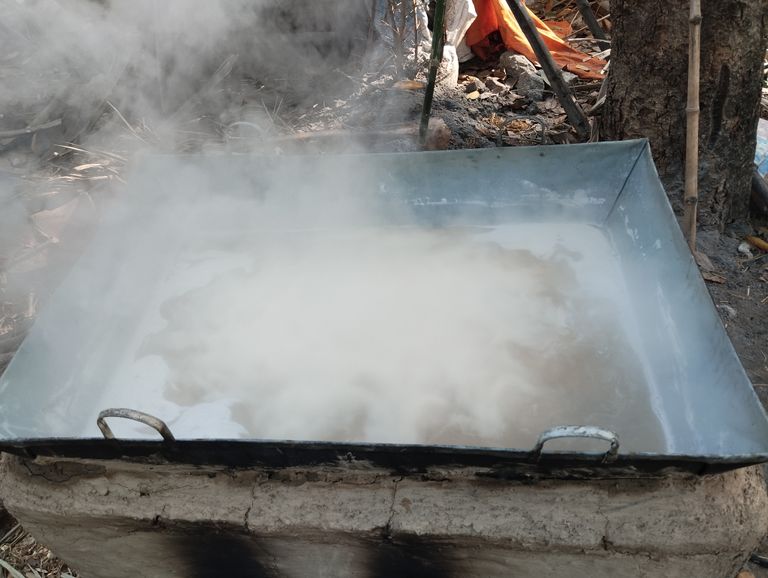
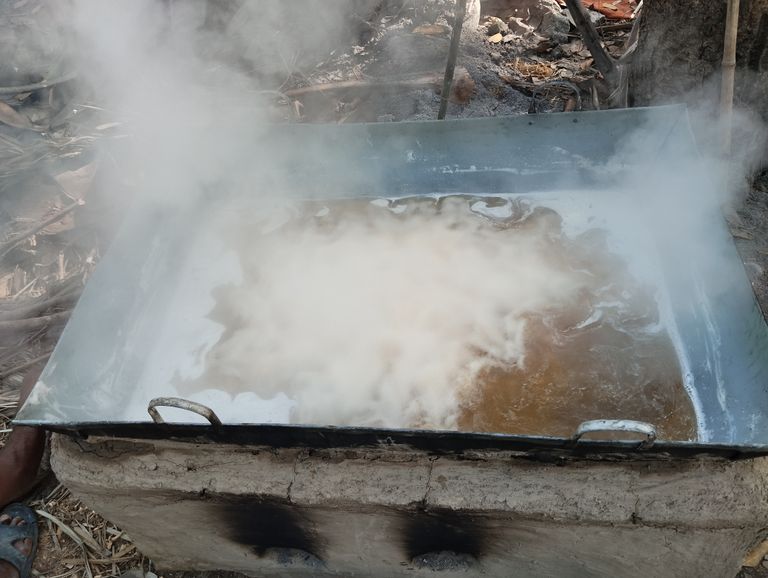
The Joy of Drinking Date Palm Sap in Winter
Winter in Bengal brings with it a unique charm – the crisp air, the festive spirit, and of course, the delicious taste of date palm sap, locally known as khajurer rosh. Extracted from the date palm tree, this natural nectar is not just a treat to the taste buds but also a symbol of winter’s arrival. Its sweet flavor and warmth-infusing properties make it an integral part of the Bengali winter experience.
The Tradition of Date Palm Sap Harvesting
The process of collecting khajurer rosh is an art passed down through generations. Skilled sap collectors, known as gachhis, climb the tall date palm trees with remarkable expertise. Using a sharp blade, they make precise cuts on the tree trunk and attach earthen pots to collect the sap that oozes out overnight. The freshly tapped sap is usually collected early in the morning before sunrise, ensuring its purity and sweetness.
This labor-intensive process, combined with the fleeting nature of winter, makes the sap a rare and prized seasonal delicacy.
The Taste and Aroma of Khajurer Rosh
The first sip of freshly collected khajurer rosh is an experience unlike any other. Its sweetness is subtle yet rich, with a hint of earthiness that reflects its natural origins. When served cold, it has a refreshing quality, while slightly warmed sap can be a comforting drink during chilly mornings. Its delicate aroma adds to the sensory delight, evoking a sense of nostalgia and connection to nature.
Health Benefits of Date Palm Sap
Apart from its delightful taste, khajurer rosh offers several health benefits:
- Rich in Nutrients: It contains natural sugars, vitamins, and minerals that provide a quick energy boost.
- Detoxifying Properties: The sap is known for its cleansing properties, helping to flush out toxins from the body.
- Boosts Immunity: Consuming khajurer rosh during winter strengthens the immune system, making it easier to combat seasonal ailments.
- Good for Digestion: The sap’s natural enzymes aid digestion and promote gut health.
Winter Delicacies Made with Khajurer Rosh
While khajurer rosh is delightful on its own, it also serves as the base for several traditional Bengali sweets and dishes. Some popular winter specialties include:
- Patali Gur (Date Palm Jaggery): When boiled and reduced, the sap transforms into thick, golden jaggery, a staple in Bengali cuisine.
- Nolen Gur Payesh: A creamy rice pudding flavored with date palm jaggery, this dessert is a must-have during winter.
- Pithe-Payesh: Traditional rice cakes, stuffed with coconut and sweetened with jaggery, are a festive treat.
- Gur Sandesh and Rosogolla: Iconic Bengali sweets get an elevated flavor with the addition of date palm jaggery.
The Cultural Significance of Khajurer Rosh
For Bengalis, khajurer rosh is more than just a seasonal beverage; it is a cultural emblem. Families often gather on winter mornings to savor fresh sap together, creating lasting memories. The sight of smoke rising from the boiling pots of jaggery preparation is a quintessential image of rural Bengal during winter.
Moreover, fairs and festivals during this time often feature stalls selling sap-based treats, further cementing its place in Bengali tradition.
Preserving a Precious Tradition
In recent years, urbanization and environmental changes have posed challenges to the traditional practice of sap harvesting. The number of date palm trees is dwindling, and skilled gachhis are becoming harder to find. Efforts are being made to preserve this heritage, from planting more trees to encouraging younger generations to take up the craft.
By supporting local sap harvesters and savoring the delights of khajurer rosh, we can play a part in keeping this cherished tradition alive.
The joy of drinking khajurer rosh in winter goes beyond its taste – it’s about embracing a centuries-old tradition, reconnecting with nature, and cherishing the simple pleasures of life. As the cold winds sweep across Bengal, a warm cup of this sweet nectar reminds us of the beauty and richness of our cultural heritage. So, this winter, don’t miss the chance to experience the magic of khajurer rosh – a seasonal treasure that warms both the body and soul.
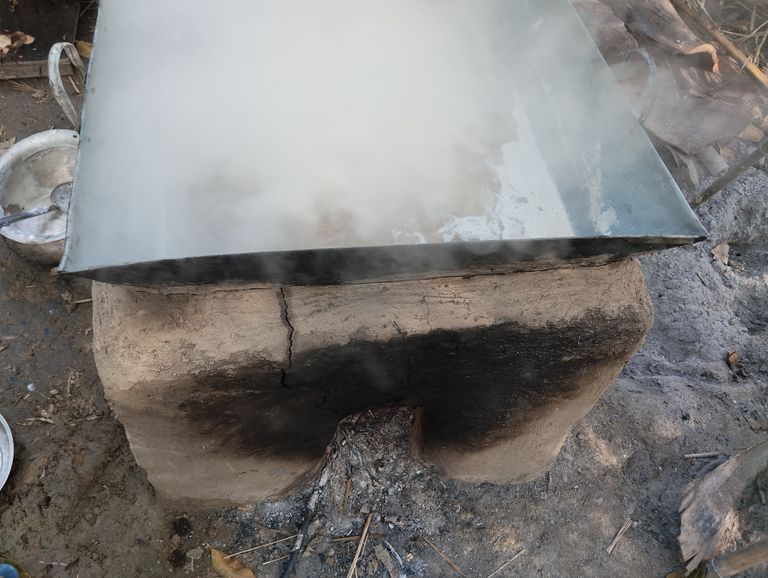
Winter Delights: Traditional Pithas Made with Date Palm Sap
Winter in Bangladesh is synonymous with the arrival of delicious traditional sweets and savory dishes made from freshly harvested date palm sap. Among these, the winter pithas (traditional rice cakes) hold a special place. These pithas, often infused with the rich, caramel-like flavor of date palm jaggery (khejur gur), are a testament to the culinary heritage of the region.
In this blog, we will explore the process, tradition, and cultural significance of making pithas with date palm sap, a winter delicacy cherished by people of all ages.
The Essence of Date Palm Sap
Date palm sap, locally known as "khejur rosh," is a natural sweetener extracted from date palm trees during winter. Early in the morning, the sap collectors (gachhis) climb the trees, carefully cut the bark, and attach clay pots to collect the sap overnight. This fresh sap is not only a source of sweetness but also carries a unique flavor that elevates any dish it touches.
As the sap is boiled, it thickens into a rich, golden syrup or jaggery. This jaggery is a key ingredient in many traditional pithas, offering an earthy sweetness and aroma that no artificial sweetener can replicate.
Popular Pithas Made with Date Palm Sap
- Pati Shapta
Pati Shapta is a rolled rice flour pancake filled with a mixture of grated coconut, date palm jaggery, and sometimes milk solids (khoya). The batter, made with rice flour, wheat flour, and semolina, is poured thinly onto a hot pan, filled with the sweet mixture, and rolled into delicious crepes.
- Bhapa Pitha
Bhapa Pitha is a steamed rice cake made by layering rice flour, grated coconut, and date palm jaggery in a small bowl or mold. The mixture is then steamed, resulting in soft, fluffy cakes with a molten jaggery center.
- Chitoi Pitha with Date Palm Jaggery Syrup
Chitoi Pitha, a soft and spongy rice cake, is often served soaked in warm date palm jaggery syrup. This combination creates a melt-in-your-mouth experience that is perfect for cold winter mornings.
- Puli Pitha
Puli Pitha is a dumpling-shaped pitha filled with a mixture of grated coconut and date palm jaggery. These dumplings are boiled in milk, creating a creamy dessert known as "doodh puli."
- Nakshi Pitha
Nakshi Pitha is a decorative pitha, often shaped by hand or with molds to create intricate designs. The dough is made from rice flour, filled with date palm jaggery, and deep-fried until golden.
The Cultural Significance of Pithas
Making pithas during winter is more than just cooking; it is a cultural celebration. Families gather around the stove, sharing stories, laughter, and warmth while preparing these delicacies. The process of making pithas often involves multiple generations, passing down recipes and techniques that have been cherished for centuries.
In rural areas, the arrival of fresh date palm sap marks the beginning of a festive season. Villages host "pitha utshob" (pitha festivals), where locals and visitors come together to enjoy a variety of pithas, showcasing the creativity and culinary artistry of the community.
Why Date Palm Sap Is Unique
Date palm sap has a distinct flavor profile that sets it apart from other sweeteners. Its natural sweetness is balanced by a slight smokiness, resulting from the traditional boiling process in clay pots over an open flame. This complexity of flavor enhances the taste of pithas, making them an unforgettable treat.
Moreover, the use of date palm sap in pithas reflects the sustainable food practices of rural Bangladesh, where every part of a tree is utilized to its fullest potential.
Pithas made with date palm sap are not just winter desserts; they are a celebration of tradition, community, and the simple joys of life. Whether you are savoring a steaming Bhapa Pitha or indulging in the creamy goodness of Doodh Puli, these dishes bring warmth to the coldest of days.
This winter, take a moment to experience the magic of pithas made with date palm sap. It is a journey into the heart of Bengali culture, one delicious bite at a time.
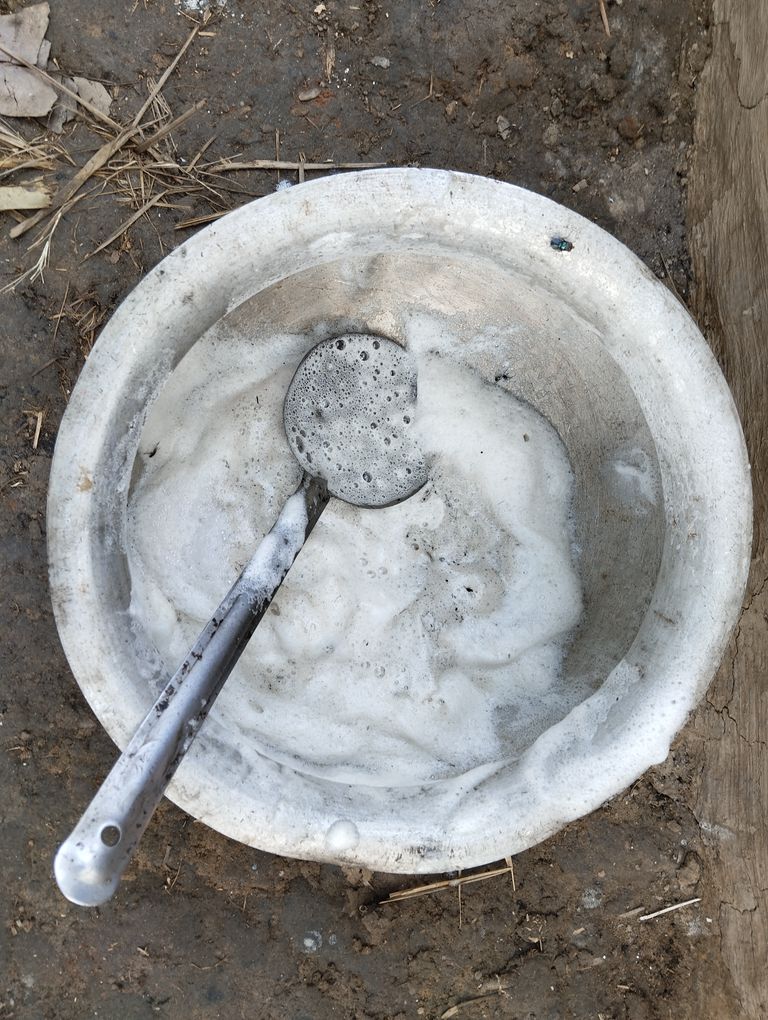
The Art of Making Huzurer Gur: A Traditional Bengali Delicacy
Huzurer Gur, or "The Lord's Molasses," is a revered sweetener in Bengali households. This traditional jaggery has a rich, caramel-like flavor and is often considered a symbol of purity and heritage. Its preparation is an art that has been passed down through generations, requiring skill, patience, and an understanding of nature's rhythms. In this blog, we delve into the intricate process of making Huzurer Gur and explore the cultural significance it holds in Bengali cuisine.
Ingredients and Materials
Before beginning, it’s essential to gather the right ingredients and tools. The primary ingredient for Huzurer Gur is raw sugarcane juice or date palm sap, depending on the type of gur being made. Date palm sap is more common in rural Bengal during the winter months.
Key Materials:
Fresh sugarcane juice or date palm sap (around 10-15 liters for a small batch)
Large iron or aluminum cauldron (locally called korai)
Firewood or a stove
Fine mesh cloth for straining
Ladles for stirring
The Step-by-Step Process
- Harvesting the Sap
The first step in making Huzurer Gur is harvesting the sap. In winter, sap collectors (locally called gachhis) climb date palm trees early in the morning to extract the sweet sap. They make a small incision on the tree trunk and hang an earthen pot to collect the sap overnight. The collected sap must be processed quickly to prevent fermentation.
- Filtering the Juice
Once collected, the sap or sugarcane juice is strained through a fine mesh cloth to remove impurities such as dirt, bark, or debris. This step ensures the gur will have a smooth texture and clean taste.
- Boiling the Sap
The filtered sap is poured into a large cauldron and heated over a fire. The boiling process is the most critical part of making Huzurer Gur. It requires constant stirring to prevent the sap from sticking to the bottom or burning.
As the sap boils, a layer of foam rises to the surface. This foam is carefully skimmed off with a ladle to maintain the gur’s purity and clarity. The boiling continues for several hours until the liquid reduces and thickens into a syrupy consistency.
- Testing for the Right Consistency
Experienced gur makers rely on their instincts and years of practice to determine when the syrup has reached the perfect consistency. A small drop of syrup is tested by cooling it on a plate. If it forms a firm yet pliable ball, the syrup is ready.
- Cooling and Molding
Once the syrup reaches the desired consistency, it is removed from the heat and allowed to cool slightly. While still warm, it is poured into molds or spread on flat surfaces to set. Traditionally, clay or wooden molds are used, giving the gur its distinctive shape.
- Final Touches
After the gur has solidified, it is carefully removed from the molds and left to cool completely. It is then stored in airtight containers to preserve its freshness.
Cultural Significance
Huzurer Gur is more than just a sweetener; it’s a symbol of Bengali heritage. It is often used in traditional desserts like pithe, payesh, and nolen gur sandesh. During winter, families eagerly await the fresh batch of gur, which is often shared with friends and neighbors as a gesture of goodwill.
In rural Bengal, the process of making gur is a community affair, with everyone coming together to collect sap, boil it, and enjoy the fruits of their labor. It’s a celebration of nature’s bounty and a reminder of the simple joys of life.
Health Benefits
Huzurer Gur is a natural alternative to refined sugar and is packed with essential nutrients like iron, potassium, and magnesium. It is believed to boost energy levels, improve digestion, and strengthen immunity. Unlike processed sugars, gur has a low glycemic index, making it a healthier choice for sweetening foods.
Preserving the Tradition
With urbanization and modern lifestyles, the traditional art of making Huzurer Gur is slowly fading. However, efforts are being made to preserve this craft through workshops, festivals, and online platforms that promote its cultural and culinary significance.
By supporting local artisans and choosing traditional gur over industrial sweeteners, we can ensure that this age-old tradition continues to thrive.
Huzurer Gur is not just a sweetener; it’s a reflection of Bengal’s rich cultural heritage and deep connection with nature. Its meticulous preparation process and unique flavor make it a treasured ingredient in Bengali cuisine. Whether used in traditional desserts or enjoyed on its own, Huzurer Gur carries the warmth and essence of a timeless tradition.
So the next time you savor a piece of nolen gur sandesh or a bowl of payesh, remember the dedication and artistry that goes into creating this golden treasure.
